This was the last match of this season in the Austrian Bundesliga as it was the second leg of the final of the play-offs. The winner would enter the second stage of the qualification for the UEFA Europa League which will be played in September.
The first leg ended 3-2 for Hartberg against Austria Vienna. Since the game was played in the capital of Austria and the away goal rule is active in this final, Austria Vienna would have needed at least two goals to get the overall win.
In this tactical analysis, we will discuss the tactics of the two teams and also look at the reasons why the game ended 0-0.
Line-ups
The home side got lined up by their coach Markus Schopp (who is linked with Milan) in a 4-1-4-1/4-1-3-2 (depending on the positioning of Rep) formation with René Swete between the sticks and the back four was made out of Christian Klem, Felix Luckeneder, Thomas Rotter and Andreas Lienhart. Bakary Nimaga was the only defensive midfielder and got support in the centre from Lukas Ried and Rajko Rep who also joined the lone striker frequently. Peter Tschernegg and Amadou Dante were the wingers while their best goalscorer Dario Tadić was the upfront.
On the other side, Christian Ilzer used the typical 4-2-3-1- formation with Patrick Pentz in goal. Andreas Poulsen (on loan from Bundesliga club Gladbach), Aleksandar Borkovic, Erik Palmer-Brown (loanee from Man City) and Florian Klein were the four defenders. Alexander Grünwald and Thomas Ebner played as double pivot behind Manprit Sarkaria. The two young talents Patrick Wimmer and Benedikt Pichler were the wingers while Christoph Monschein was the central forward.
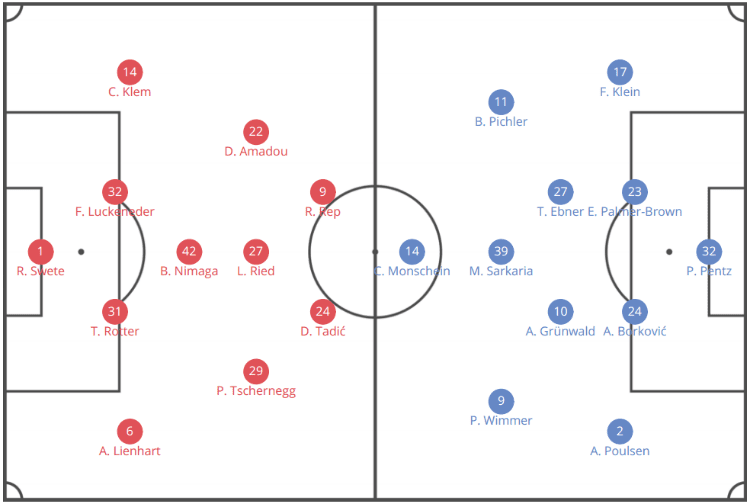
Austria Vienna’s offensive approach and why it failed
Since a 0-0 would have meant that Hartberg would win that final and Austria Vienna needed to score at least two goals, everyone expected the team of Schopp to be more defensive and passive to focus on stopping the opponents from scoring goals. However, they were very active and in the first half also clearly the better side while logically it got more hectic in the second 45 minutes.
Anyways, in the first part of this tactical analysis, I want to discuss the ideas and plan of Austria Vienna which got visible during the first about 20 minutes and then explain the reasons why it failed.
Overall, Ilzer’s side was not dominant, but they had more possession and wanted to score as early as possible. When they had possession, Hartberg defended in their 4-1-3-2 formation which often turned into a kind of a 5-3-2 as Dante dropped on the left side almost on the same height as the back four and Rep moved up to be next to Tadić. They did this especially when they dropped a bit deeper and put pressure on the Veilchen at about the halfway line. They were in different periods also defending higher up the pitch as we will see in the second part of this tactical analysis. Below, we can see their 5-3-2 when they defended deeper.
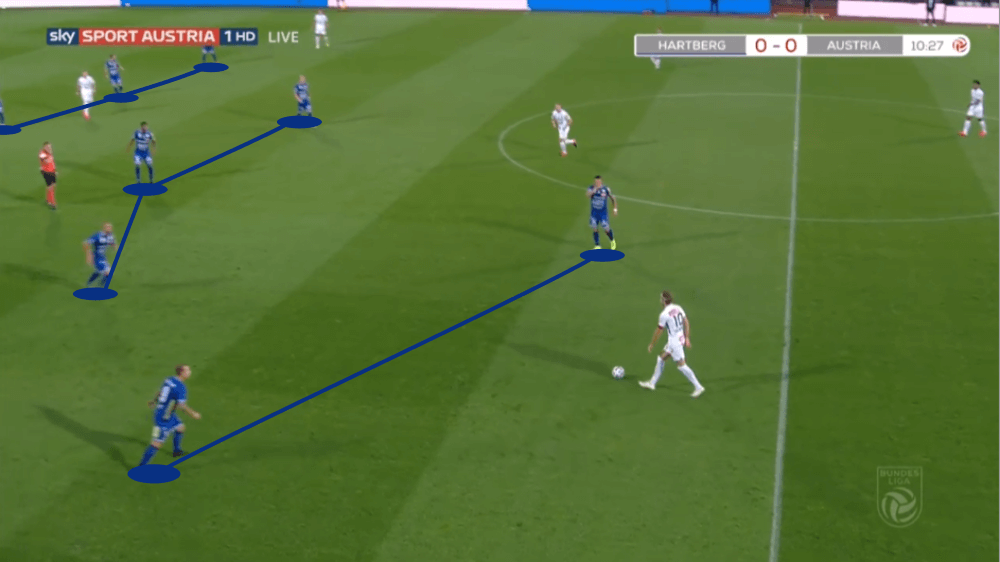
Vienna’s left-back Poulsen was one of the central men in the tactics of Ilzer as he has a lot of stamina to go down the left wing for 90 minutes and additionally is a very explosive player. Since Rep who was mainly the right player in the first line and Tschernegg were positioned very central, Poulsen had often a lot of space on the wing to be positioned high during the build-up and additionally drive forward with the ball at his feet.
Below we can see an example of how high he pushed forward as he has got enough space on the left wing.
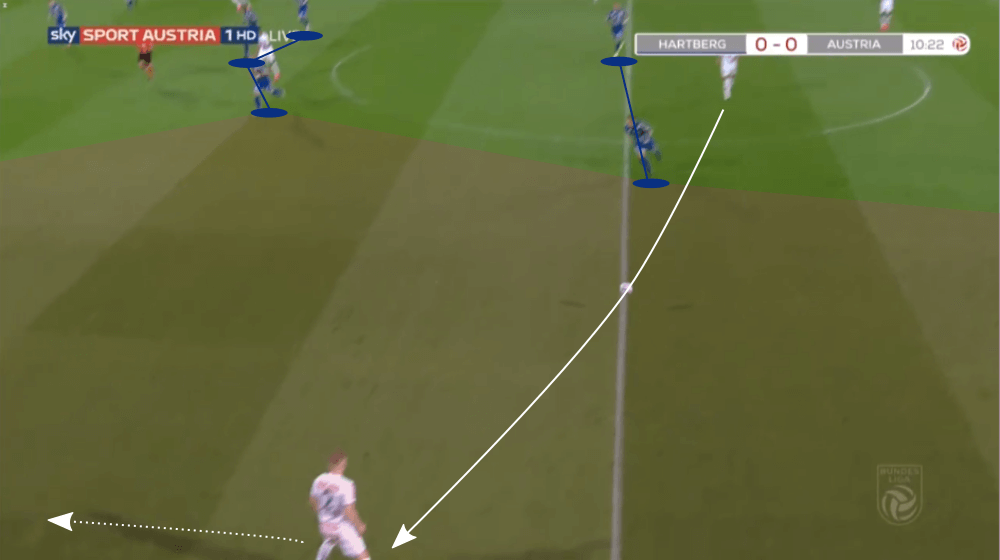
This advanced area on the left wing was the space in the tactics of Austria Vienna from where they wanted to play slightly diagonal or vertical through passes behind the last line of Hartberg. By doing this, they wanted to exploit the pace of their forwards.
Furthermore, this high positioning of Poulsen had another aspect: the defensive midfielder Grünwald could position deeper on the left side to the play exactly these through passes with his strong left foot. Below, we can see an example as the captain drops deeper on the left side while Poulsen is positioned higher. The striker Monschein then starts his diagonal run from the right side into the centre to receive the long through ball. Unfortunately, he is ruled offside.
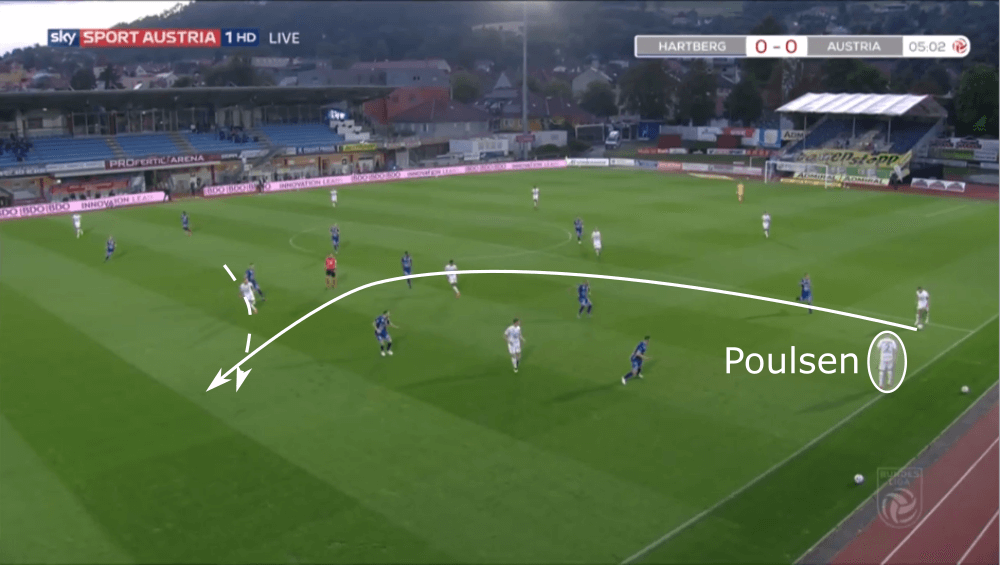
This described pattern was the central part of Austria Vienna’s tactics besides the forward runs of Poulsen and that the offensive midfielder Sarkaria should permanently position between the lines of the opposition. The latter aspect worked basically quite well even though the Austrian is a natural winger.
He positioned repeatedly intelligently in free spaces in the formation of Hartberg, but he always received the ball with the back to the opposition’s goal and then mainly just played it backwards. We could clearly see that he tried hard, but players like Dominik Fitz (injured) or Maximilian Sax (on the bench) are just more used to these situations and therefore find easily more solutions.
During the first about 10 minutes, it looked like Austria Vienna’s tactics could really work out at some point. However, Tschernegg had then the task to be positioned a bit wider during the defensive phase, so he could stop the progressive runs of Poulsen and it immediately helped. Below, we can see how Tschernegg has moved more to the wing to take out the tempo of the run of the Dane who then plays the ball back to the centre-back.
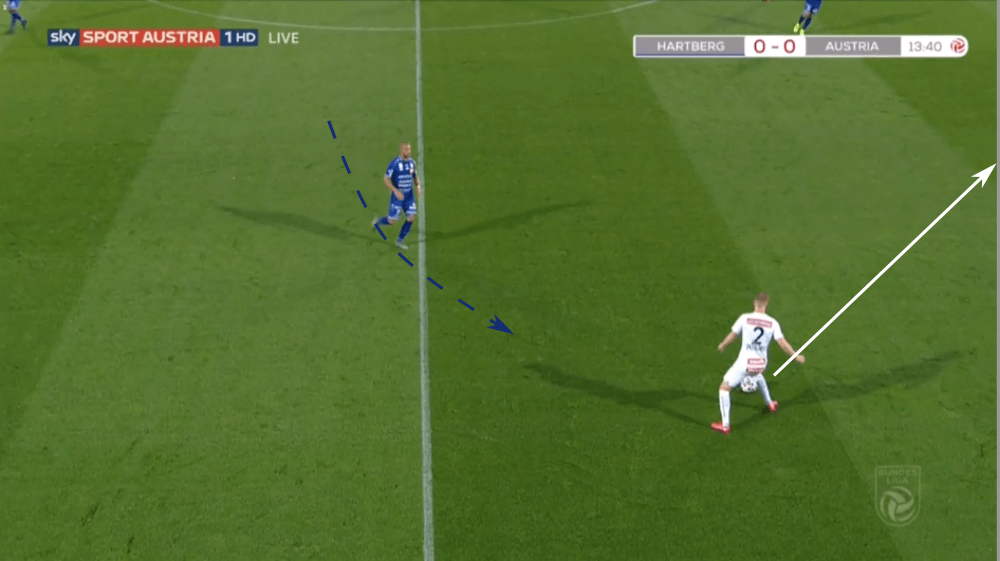
After about 20 minutes, Poulsen got injured and had to be subbed off. The only defender on the bench of Vienna was the centre-back Maudo Jarjué and therefore everyone expected Ilzer to bring on the 22-years-old and move Borkovic out to the left side as he can also play as left-back. However, he brought on Vesel Demaku who played in front of the defence besides Grünwald and Ebner went back to play as left wide-defender. This had several bad consequences.
Firstly, Ebner is a hard-working and disciplined player but doesn’t drive forward that aggressively as Poulsen does. Besides, he didn’t push forward that frequently what meant that Grünwald couldn’t drop to the left side to play the lobbed through balls. And lastly, Ebner is often the player who has to be quite defensive in midfield to give Grünwald more offensive freedom. On the other side, Demaku is also a more offensive-minded midfielder and due to that Grünwald had to act more defensively and he couldn’t help his team that frequently in the higher areas. Below we can see Austria Vienna’s new formation (in possession) after the change.
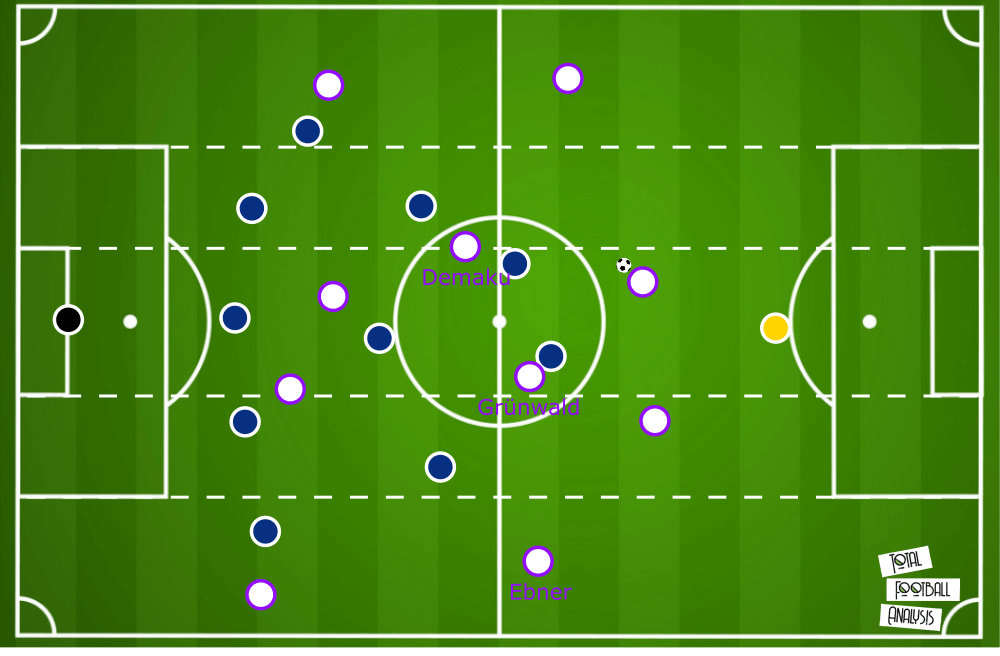
The opening 20 minutes were by far the best by the Veilchen. They weren’t able to create anything really dangerous, but the through passes and Poulsen’s runs were quite promising. During the remaining time of the game, it seemed as they would have no other plan on how to get into a dangerous position for scoring a goal.
The defensive tactics of both sides
In this part of the tactical analysis, we will look at the pressing tactics of both sides. Hartberg occasionally dropped back deeper in some phases of the game as we already saw earlier, but also pressed higher up the pitch in the right situations.
Nowadays, we can often see that strikers use curved runs to force the opposing centre-back on his outside foot to play the ball to the full-back who then gets pressed. This pressing pattern is probably the most common one.
However, in this match, Hartberg went for a different kind of press and did so especially when Palmer-Brown had the ball. It was often Rep who used a curved run to force the Man City loanee to dribble to the inside what meant that the right centre-back had the ball on his weak left foot. It rarely paid off with a high recovery, but Austria Vienna was often not able to have a structured build-up due to that. We can see an example of that below.
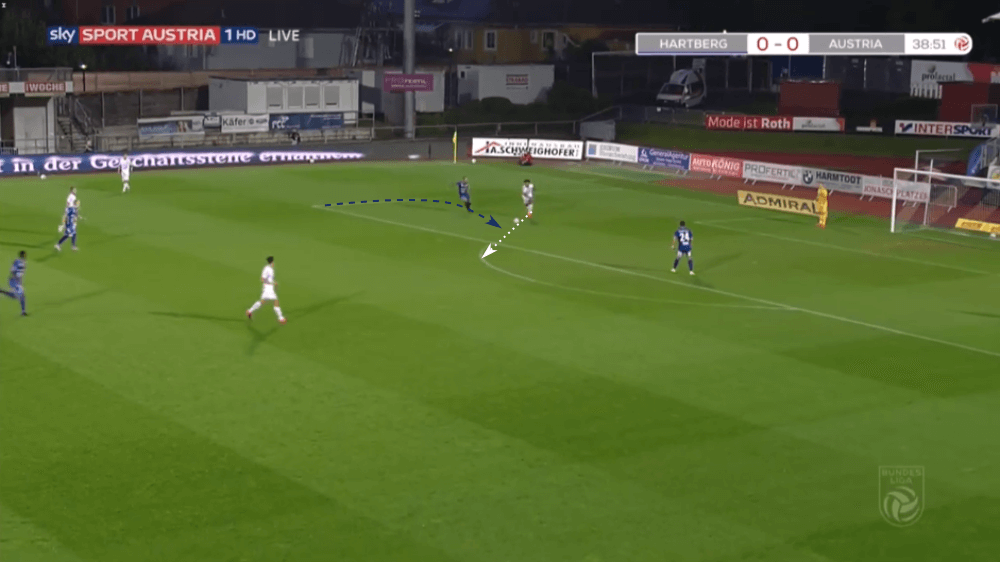
Anyways, the press of Hartberg could sometimes be even more effective if the whole team realised earlier that they would want to put pressure on the opposition. We sometimes saw that Rep and Tadić started the press, but the other eight players didn’t push up early enough what led to a gap between them what Vienna exploited. Below we can see an example as the move up too late what then results in a foul instead of a recovery.
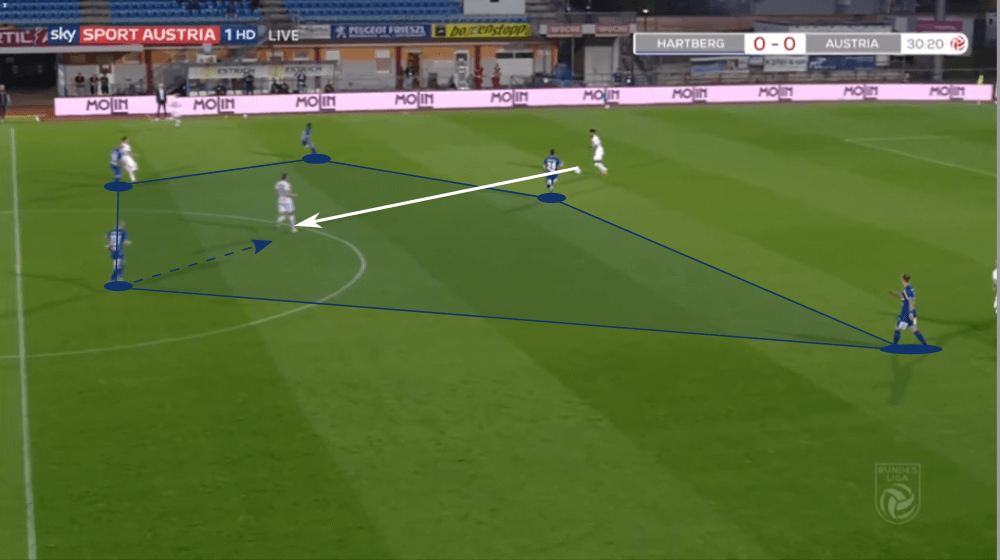
On the other side, Austria Vienna were very active without the ball and used most of the time a high pressing. In those periods, Sarkaria joined Monschein in the first lien to create something like a 4-4-2. We can see an example for that below.
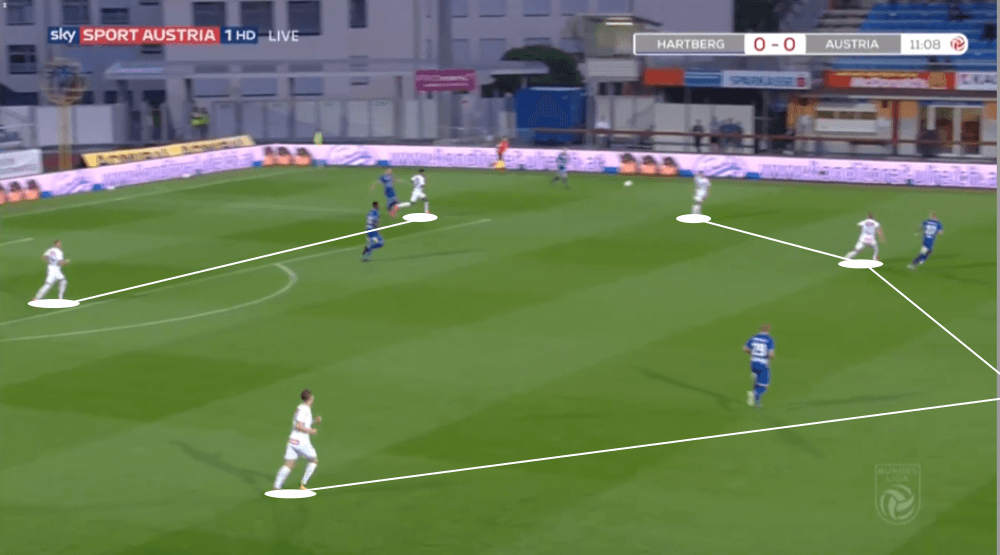
However, their pressing was often extremely ineffective since Hartberg were either able to bypass it with short passes or went for the long ball towards Rep or Tadić who have the class to stay in position until their teammates join them.
It was amazing to see several times how weak the pressing of Vienna was since Hartberg were able to bypass it after a short goal kick over and over again. Swete played it short to Nimaga who then laid it off for Luckeneder. The idea behind that was to have the good ball-playing centre-back Luckeneder with his body orientation towards the opposing goal on the ball as quick as possible. The Austrian then looked for passing options and the good movements of his teammates in the higher lines often helped him.
Several times throughout the game they were able to overcome the first lines of Austria Vienna’s press to then have logically a lot of space in the final third. Below, we can see an example of that. Note that between the two images, Nimaga, Swete and Luckeneder created a triangle and had a little combination to get Luckeneder in this position.
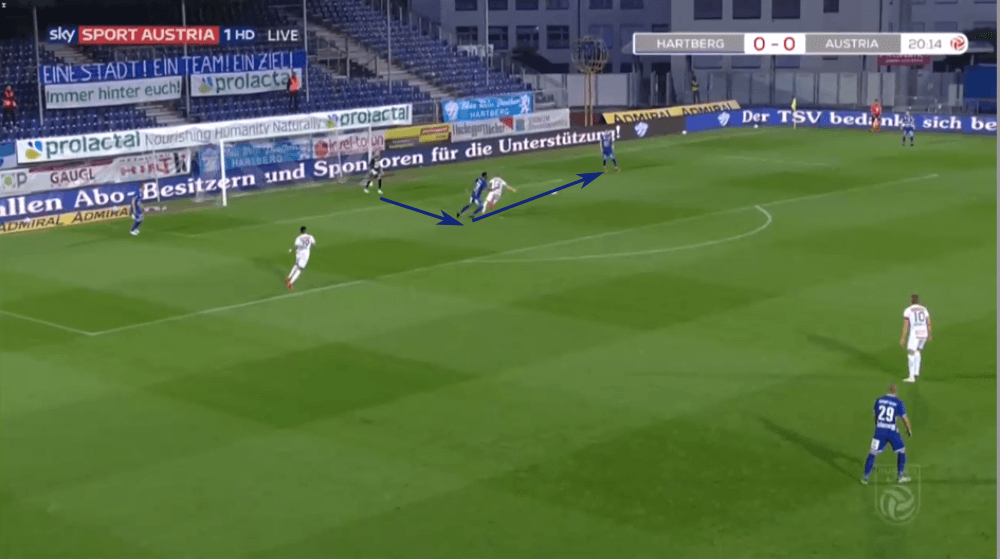
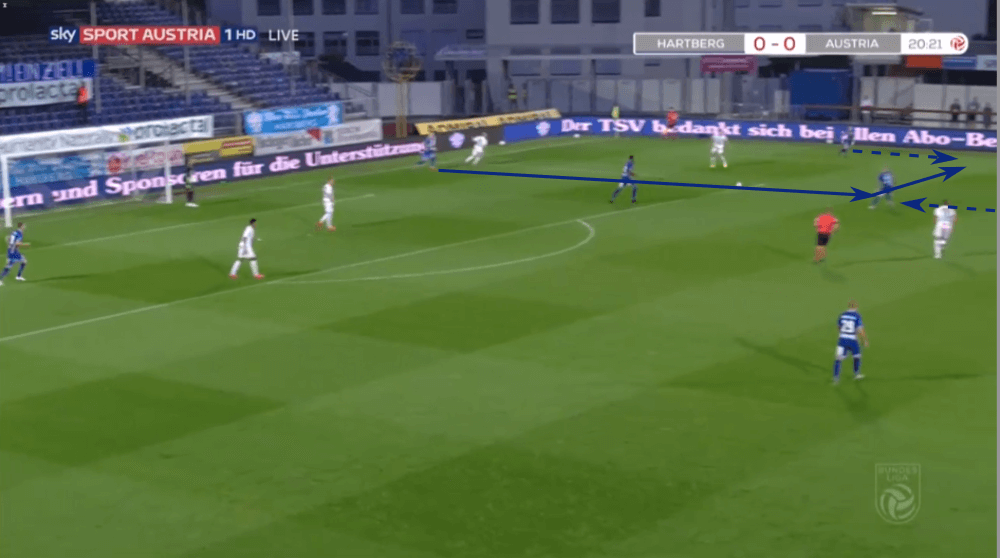
Rep as the central man for Hartberg
The Slovenian Rep was for his team once more incredibly important in this game due to his great technical abilities and the decent vision. He had the freedom to be positioned all over the field as he permanently looked for free spaces to open up passing lanes towards him. In his heatmap for this game below, we can see this aspect of his game.
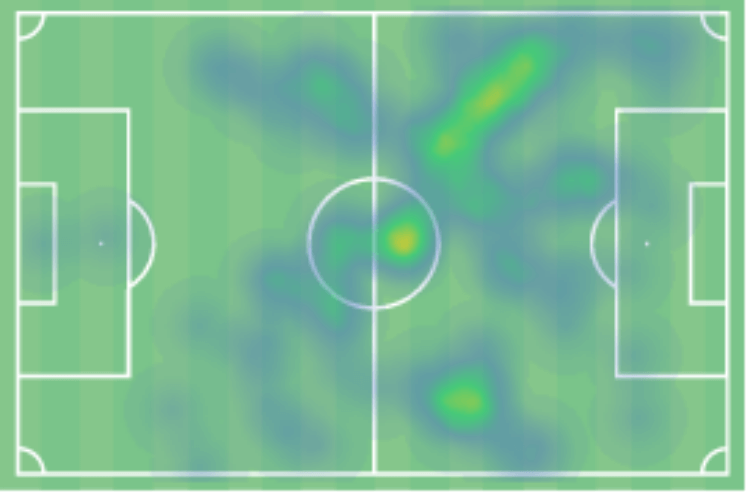
As already mentioned, when Hartberg were not able to find a way to overcome the pressing of the opposition with short passes, they went for the long ball towards one of their two stars, Rep and Tadić. But not only in these moments, the long ball was often a way to get forward since they also used it during the offensive transition.
No matter in which situation, the teammates of the receiver immediately moved close to him to give him either an option for a layoff or to win the second ball. In the example below, Rep receives a long ball and the two wingers Dante and Tschernegg move into the centre to be near him.
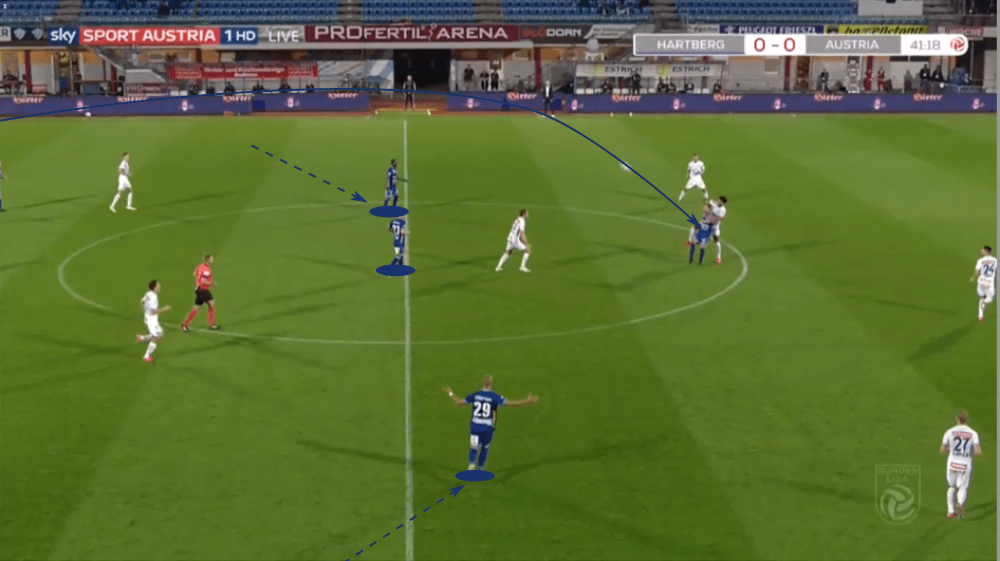
Besides, Rep is surely the player in Hartberg’s squad with the best vision and knows how to create something dangerous. In this match, he was once more able to show off his great abilities as he created several dangerous situations for his teammates or himself. Below we can see an example for a through pass for Tadić which unfortunately leads to no goal.
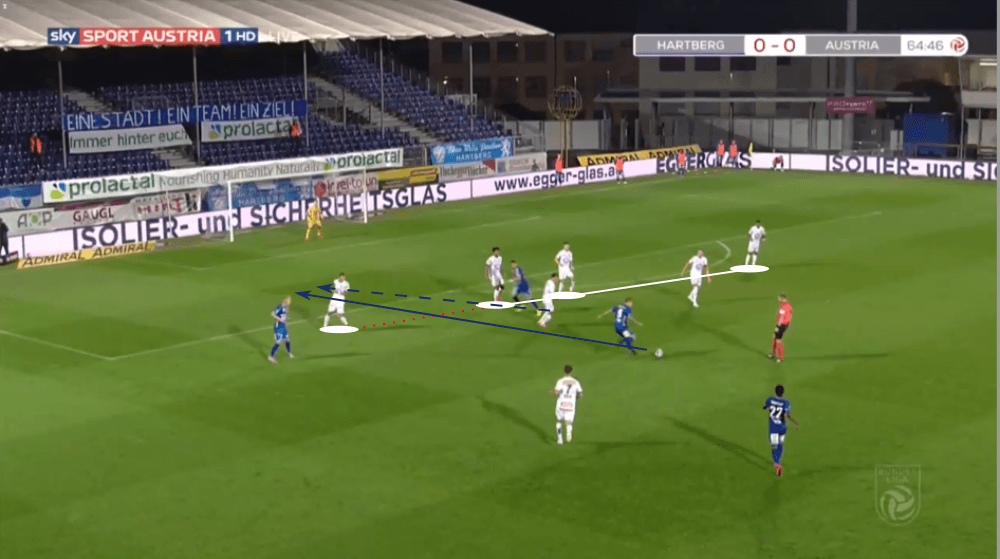
Conclusion
Overall, the draw was a fair result since both teams were rarely able to create something really dangerous and Hartberg had even bigger chances than the opposition. The injury of Poulsen was hard for Austria Vienna to compensate, but the positional change of Ebner made it even harder. This was surely no perfect decision by Ilzer.
Still, Hartberg being in the final in the play-off surely the greatest positive surprise of this season in the Austrian Bundesliga while Austria Vienna is besides Sturm Graz, the team which disappointed us the most. It will be interesting to see if Schopp will stay at Hartberg and which changes Austria Vienna will make.





Comments